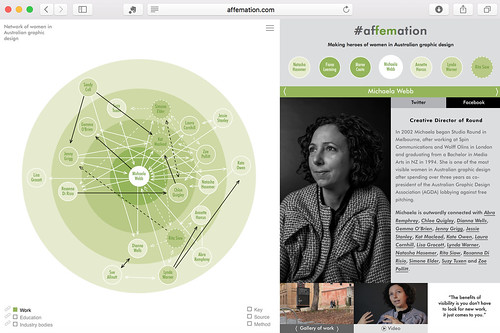‘Alphabettes.org is a showcase for work, commentary, and research on lettering, typography, and type design. Our loose network is here to support and promote the work of all women in our fields.’
Find out more about this excellent initiative on www.alphabettes.org or the twitter feed twitter.com/alphabettes_org
Thursday 23 August 2018
Black Pin
This set of posters by Catherine Griffiths highlights the unequal balance between male and female designers in the Designers Institute of New Zealand's Black Pin awards.
'Each year the Designers Institute of New Zealand awards two Black Pins, its supreme award. For the past two decades, 43 Black Pins have been awarded, of which 40 have gone to men and 3 to women. For this year’s Best Design Awards (to be announced in September), of the 9 convenors of juries for judging the nine main categories and various sub-categories, 8 are men and 1 is a woman. Of the jurors and convenors combined, 46 are men and 15 are women. The jury for the Value of Design Award is made up of men only, no women. How has this happened? Where are the women?'
Read more on Catherine's Twitter feed or on alphabettes.org
'Each year the Designers Institute of New Zealand awards two Black Pins, its supreme award. For the past two decades, 43 Black Pins have been awarded, of which 40 have gone to men and 3 to women. For this year’s Best Design Awards (to be announced in September), of the 9 convenors of juries for judging the nine main categories and various sub-categories, 8 are men and 1 is a woman. Of the jurors and convenors combined, 46 are men and 15 are women. The jury for the Value of Design Award is made up of men only, no women. How has this happened? Where are the women?'
Read more on Catherine's Twitter feed or on alphabettes.org
Women in type
A social history of women’s role in type-drawing offices, 1910–1990
A lecture by Fiona Ross and Alice Savoie
Atypi Antwerp
13 September 2018, 9:20am
Fiona Ross and Alice Savoie will introduce a significant new University of Reading research project funded by the Leverhulme Trust that draws on their experiences as type designers and historians. Fiona and Alice will describe how this interdisciplinary research project will provide the first socio-historical analysis of women’s role in the male-dominated British type-manufacturing industry during the 20th century. The project examines the positions women achieved and their responsibilities in the type-drawing offices of the British companies of Monotype and Linotype, at a time when the industry was transformed by external socio-historical factors and significant technological developments. The research team, which includes Helena Lekka, examines this subject in three interrelated ways: in terms of social history; in relation to technological developments; and in terms of contributions to typeface design. The talk will illustrate how, through archival research and interviews, an account can be recorded of the largely overlooked, yet pivotal, involvement of women in the type design process. The research project aims to make a significant contribution to social and design histories, while informing current design practitioners.
More info and tickets on the Atypi website
A lecture by Fiona Ross and Alice Savoie
Atypi Antwerp
13 September 2018, 9:20am
Fiona Ross and Alice Savoie will introduce a significant new University of Reading research project funded by the Leverhulme Trust that draws on their experiences as type designers and historians. Fiona and Alice will describe how this interdisciplinary research project will provide the first socio-historical analysis of women’s role in the male-dominated British type-manufacturing industry during the 20th century. The project examines the positions women achieved and their responsibilities in the type-drawing offices of the British companies of Monotype and Linotype, at a time when the industry was transformed by external socio-historical factors and significant technological developments. The research team, which includes Helena Lekka, examines this subject in three interrelated ways: in terms of social history; in relation to technological developments; and in terms of contributions to typeface design. The talk will illustrate how, through archival research and interviews, an account can be recorded of the largely overlooked, yet pivotal, involvement of women in the type design process. The research project aims to make a significant contribution to social and design histories, while informing current design practitioners.
More info and tickets on the Atypi website
Image from @alphabettes_org Twitter feed
Tuesday 14 August 2018
A week at Eike König’s female-led and thought-provoking After School Club
“With money no consideration, After School Club represents something very unique in the
design industry, usually an elitist environment due to the middle-class
white men who act as its gatekeepers. Instead, it refreshingly presents
an equal playing field of disciplines, backgrounds and identities. It
comes as no surprise, therefore, that its fourth edition this year
embodied this naturally forward-thinking ethos into its line-up,
inviting only female speakers.”
An article by Lucy Bourton on It's Nice That

Image: Isabel Seifert
Read the article here.
Visit the After School Club's website.
An article by Lucy Bourton on It's Nice That

Image: Isabel Seifert
Read the article here.
Visit the After School Club's website.
afFEMation — influential women in Australian design history
afFEMation is a website and project “making heroes of women in Australian graphic design”

In 2016 Jane Connor sent an online survey out to stakeholders in the graphic design industry in Australia, asking them to list women who had made a significant contribution to graphic design in Australia since 1960. 142 names were listed and the top 25 most mentioned women were approached to take part in this project.
The afFEMation project stems from her belief that designers included in the history of Australian graphic design should be measured by their local influence rather than by their connections abroad, Connor writes in a post on Eye Magzine's blog.
Visit the website of the project: http://www.affemation.com/
See also the article on Eye Magazine: http://www.eyemagazine.com/blog/post/invisible-women-in-australian-graphic-design
Subscribe to:
Posts (Atom)




